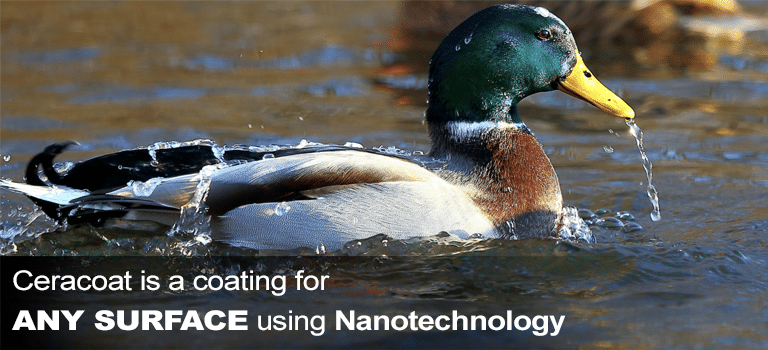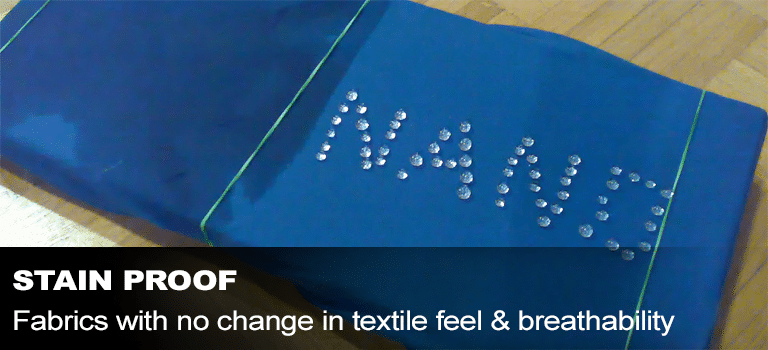









Frequently Asked Questions Ceracoat
da Dr. Elio Keller, Presidente Ceracoat Industries
Che cos'è la nanotecnologia?
The definition most frequently used by government and industry involves structures, devices, and systems having novel properties and functions due to the arrangement of their atoms on the 1 to 100 nanometer scale.
Many fields of endeavor contribute to nanotechnology, including molecular physics, materials science, chemistry, biology, computer science, electrical engineering, and mechanical engineering.
Due to the extreme breadth and generality of this definition, many prefer to use the term “nanotechnologies”, For clarity, it is also useful to differentiate between near-term and long-term prospects, or to segment the field into first-generation through fourthgeneration stages.
More detailed, Nanotechnology is the description of the science that is able to treat particles that are one billionth of a meter. This is about 100000x thinner than a strand of hair. Scientist have created microscopes which allow them to see them and tools like reactors and mills to manipulate these tiny particles.
With CERACOAT nano technology we are able to create very thin coatings, like a thin protection “film” on any surface, to protect these surfaces from all exterior influences (liquid, dirt, temperature, scratching, fire, odor, wear). By molecular self-organization, the nano-metric building blocks of Ceracoat form an invisible layer / coating on any surfaces. This nano-structuring process works downwards, sideways and upwards resulting in a 3-dimensional protective network. At the same time, the positive characteristics like breathing activity and touch of the surface are retained completely.
Crevices on surfaces are usually much larger and make this technology ideal for use as a surface coating because the particles are small enough to fill these crevices and not be detectable to the human touch.
Thanks to the latest developments in NANO technology, there is now a product that reduces the Effort for cleaning, saves time and money and works on ALL surfaces from bathroom tiles, floors and kitchen sinks to furniture and even clothes: CERACOAT.
The CERACOAT product family (absorbent and non-absorbent surfaces, vehicle care, engine protectant) works on all surfaces from glass and textiles to metal or plastics. With so many possible applications, CERACOAT is the essential all-purpose surface Protection in every-day life all around the house and car.
Simply for perfect results, most CERACOAT products/liquids are colorless and form an invisible protection coating on all surfaces. Dirt and stain do not adhere to surfaces any longer. Even heavy stains like red wine stains, which can ruin expensive clothes or carpets, are simply wiped off!
Due to its superior product qualities, CERACOAT owns distinctive advantages. Particularly in a saturated market, CERACOAT offers unique growth potentials and new market chances to retailers. Since CERACOAT can be used for a wide range of applications, an extremely large Group of buyers is targeted: The whole population!
Why develop Nanotechnology?
Gaining better control over the structure of matter has been a primary project of our species since we started chipping flint. The quality of all human-made goods depends on the arrangement of their atoms. The cost of our products depends on how difficult it is for us to get the atoms and molecules to connect up the way we want them. The amount of energy used – and pollution created – depends on the methods we use to place and connect the molecules into a given product. The goal of nanotechnology is to improve our control over how we build things, so that our products can be of the highest quality and while causing the lowest environmental impact. Nanotech is even expected to help
us heal the damge our past cruder and dirtier technologies have caused to the biosphere.
Nanotechnology has been identified as essential in solving many of the problems facing humanity. Specifically, it is the key to addressing the Foresight Nanotech Challenges:
- Providing Renewable Clean Energy
- Supplying Clean Water Globally
- Improving Health and Longevity
- Healing and Preserving the Environment
- Making Information Technology Available To All
- Enabling Space Development
Where is Nanotechnology being developed?
Research and development of nanotechnology is taking place worldwide. As this is written, government spending is at approximately one billion U.S. dollars in each of four global areas: (1) the United States, (2) Europe, (3) Japan, and (4) the rest of the world, including China, Israel, Taiwan, Singapore, South Korea, and India. Similar amounts are said to be being spent in the private sector, with these figures being quite difficult to determine accurately due to the breadth of the nanotech definition, which includes a large number of older technologies.
How can nanotechnology promise to build products with both extreme precision in structure, and environmental cleanliness in the production process?
Traditional manufacturing builds in a “top down” fashion, taking a chunk of material and removing chunks of it – for example, by grinding, or by dissolving with acids – until the final product part is achieved. The goal of nanotechnology is to instead build in a “bottom-up” fashion, starting with individual molecules and bringing them together to form product parts in which every atom is in a precise, designed location. In comparison with the top-down approach, this method could potentially have much less material left over, greatly reducing pollution.
In practice, both top-down and bottom-up methods are useful and being actively pursued at the nanoscale. However, the ultimate goal of building products with atomic precision will require a bottom-up approach.
Which country leads in Nanotechnology?
World leadership in nanotechnology varies according to which sub-category of technology is being examined. In general, nanotechnology is unlike a number of recent major technological innovations in that the U.S. does not hold a very strong lead at the start. High quality work is taking place around the world, including countries with a higher fraction of engineering graduates, much lower R&D costs, and (unfortunately) lessstringent environmental standards. But we can still consider that the one of the leading countries is Germany with the INM (institute for new materials, a Nanotechnology specialized university) in Saarbrucken, and the Saarbrucken region that is called “nanovalley”. Ceracoat is in close contact with the INM for its R&D.
Are there any safety or environmental issues with the Nanotechnologies in use today?
Concerns have been raised regarding potential health and environmental effects of the passive nano structures termed “nanoparticles”. Regulatory agencies and standards bodies are beginning to look at these issues, though significantly more funding for these efforts is required. Foresight is working with the International Council on Nanotechnology to address these concerns.
One important issue is to know, what kind of Nanotechnology products are you using and if there are “nanoparticles” in the liquids. Ceracoat uses the “sol-gel” process to produce their products. In a sol-gel process, no particles are in the liquid, so, Ceracoat products are completely safe and due to the fact they are water-based, also environmentally friendly.
How can I participate in or influence the nanotech revolution?
By becoming part of the Ceracoat-Family. By becoming a Ceracoat distributor to help change human habitudes, make all-day-life easier, help people save time & money by preventing nature.
How do Ceracoat coatings work? What is it?
Ceracoat coatings are ceramic coatings for every surface you can imagine. We just add a very thin (under 100 nanometers) ceramic (natural material in a water solution) film/layer on a surface to make it liquid and dirt repellent. Surfaces will remain clean much longer, can be cleaned just by absorbing the dirt (if liquid) with an absorbent paper or by rinsing it with water (non liquid dirt), or just by polishing the dirt away.
https://www.youtube.com/watch?v=qMJA0Et5zCM&index=1&list=PL8AE7AF3616386453
Ceracoat Ceramic Nanotechnology incorporates nano-sized ceramic particles into a smart formula providing added protection to surfaces.
Ceracoat Products coat the crevices in surfaces with fibers so small that dirt, liquid, cannot penetrate into them. This process is completely harmless to hard and soft surfaces and your family! Imagine that you put a glass panel on a towel. The towel absorbs liquid and dirt, if you put a glass panel on the towel, the towel is completely protected against liquid and dirt by this glass. This is how nano technology works. The nano-coating (ceramic) is so thin, that you cannot see of feel it, and it is completely flexible and does not change the surface).
Benefits of Ceracoat Ceramic Nanotechnology:
- Long-term protection against liquids and dirt
- Odorless and invisible
- Reduces the need to clean – surface can be cleaned only with water – no cleaners needed any more – Does not change appearance
- Does not change touch
- Allows surfaces to continue to breathe
Technical Information about Ceracoat thanks to Nanotechnology:
- Harmless
- Foodstuff neutral
- Skin neutral
- Free from solvents silicone and oil -Ecologically sound – UV stable -High temperature resistance
The Ceramic technology used in Ceracoat is a similar technology used by NASA on the tiles on their space ships. The ceramic technology coats the spaceship to protect it when re-entering the earth’s searing hot atmosphere. Two of the NASA scientists very involved in the improvement of ceramic technology to bring it to the application it is at today, later came to work for Ceracoat and help create the Ceracoat Ceramic products.
Ceracoat Ceramic Products are engineered in Switzerland using Swiss quality and precision since 1988.
Do Ceracoat coatings always work?
Yes, they do. You have to respect the applications like indicated in our homepages, videos, products descriptions, labels on the respective products. If you respect the “how to use” like for example to use enough product, to pay attention the surface is clean, to pay attention the surface is not already coated with anything else, to respect to let the coating be 100% dry and other conditions, Ceracoat coating will always work.
https://www.youtube.com/watch?v=F7JL3H4DziA&list=PL56A1290B94BA1014&index=72
What is the difference between Ceracoat and other Nanotechnology products?
There are a lot of differences, and we can just talk about some of them, but one of the main differences is that Ceracoat products are Nanotechnology products of the next generation like for example our glass care. This product does not only coat and is ethanol based like the “others”. This product is a cleaner, renovator, a coating and makes the surface smoother, is not ethanol based but water base, so completely safe and foodstuff neutral.
https://www.youtube.com/watch?v=DoFzlHtborc&list=UUdOAp-_CcQypLmavr6yrSaw
How long do Ceracoat coatings last?
https://www.youtube.com/watch?v=e_0U7VNqDlY&index=11&list=PL8AE7AF3616386453
What is the REAL price for Ceracoat coatings / products?
Someone told us, he found a cloth protectant from another company for 20 $ only (Ceracoat is 39 $!) Well: That other product resists to 40°C washing once. Ceracoat resists to 60°C and 30-40 wash cycles. For 30 wash cycles, you will need 30 bottles of the other product which is 600 $ and not just 39 $ like for Ceracoat. This is the REAL price.
https://www.youtube.com/watch?v=QRQMTErM7Ak&index=9&list=PL8AE7AF3616386453
Why are Ceracoat Nanotechnology products completely safe?
The nano materials used for Ceracoat are processed in liquid form and generally involved in a so-called binder matrix. The binding matrix is typically a kind of varnish. This means, that individual nano particles may not be released at any stage of the product cycle. All currently available worldwide studies confirm this clearly. There is no risk from the nano materials that are included in a hardened coating, and besides that, Ceracoat is using the Sol-Gel process for its liquids, so there are no nano particles in the liquids. This can be explained with “sugar water”. You can add sugar to water and mix it to drink. If you would do a professional mixing, the sugar particles would be 100% diluted in the water, you will not find any more solid particles in the water. Then, with temperature and the right chemical process you can again separate that “sugar-water” and bring back the liquid (water) and the solid particles (sugar). This explains in a simple way, why there are no particles in our liquids and when the coating is built, the nano coating is organized as a “matrix” and not as single particles.

DR. ELIO KELLER
President Ceracoat Industries